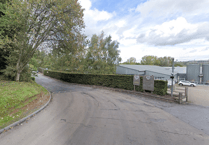In recent years the River Chew has suffered considerable ecological stress.
This has not only been due to the discharge of sewage by water companies, but also low river levels and flow, high water temperatures, low oxygen levels, run-off of phosphates and nitrates from agriculture, silting, and the accumulation of other toxic chemical and pesticides from the general population.
All this has had a detrimental effect on the plant, fish and invertebrate life in the river Chew.
The Bristol Avon Rivers Trust (BART) is a charity concerned with improving the aquatic environment in the whole of the Bristol Avon river catchment, but they have identified the river Chew as one of their priority areas.
However, it’s only by having volunteers on the ground that they can really see what is going on and so relay information to the Environment Agency and other interested parties.
Charlie Tricks, member of Chew Valley Nature Recovery Network Steering Group, explains the process of gathering data from the river: “For seven years now we have enjoyed being a Riverfly monitor on the river Chew between Publow and Pensford.
“This involves a monthly survey of eight different invertebrate groups (taxa) in the river. These eight taxa have been shown to give a good indication of the river’s health. Each survey takes a couple of hours and is sampled at a specific small section of the river. It involves getting into the river in a pair of waders and kicking the riverbed just above a specially designed net for a total of three minutes. After rinsing the sample, it goes into a shallow white, water-filled tray where the real business begins.
“I then have to separate out the eight different taxa into separate containers and count their numbers. The taxa include freshwater shrimp, and seven insect larval groups including mayflies, caddis flies, stoneflies, olives and others. This bit is not easy, takes quite a bit of practice, and reminds me of A-level biology fieldwork at school. Not only though do each of these groups look different, they also move in the tray in different ways, and now I initially identify the invertebrate by its movement before checking its close features.
“I find the whole process easier by taking six kick samples of 30 seconds each in slightly different positions across the river and analysing each before proceeding to the next one. This also makes it more interesting as I learn more about which species tend to inhabit which habitat at different seasons and water conditions. With 7 years’ worth of data from the same site I have learnt a lot about freshwater ecology first-hand.
“Having analysed the whole sample, each taxa is given a score from 0-4 depending on the numbers found. All the invertebrates are then returned, alive, to the river. The individual taxa and total scores are then reported online to BART and the national Riverfly partnership. Each site is also allocated a threshold score, and scores below the threshold trigger an alert which, if verified, will go to the Environment Agency for further investigation. My data have also been used as evidence to increase the summer compensation flow down the Chew from Chew Valley lake.”
BART supervise the training of Riverfly monitors locally and are always very keen to get more volunteers throughout the Avon catchment area. They also have a number of less arduous citizen science projects. If you are interested in volunteering for BART or other organisations in the Chew Valley, useful information and links can be found at: cvnrn.org/volunteer. For more information on Riverfly monitoring, see The Riverfly Partnership (riverflies.org)


.jpg?width=209&height=140&crop=209:145,smart&quality=75)
.png?width=209&height=140&crop=209:145,smart&quality=75)

Comments
This article has no comments yet. Be the first to leave a comment.